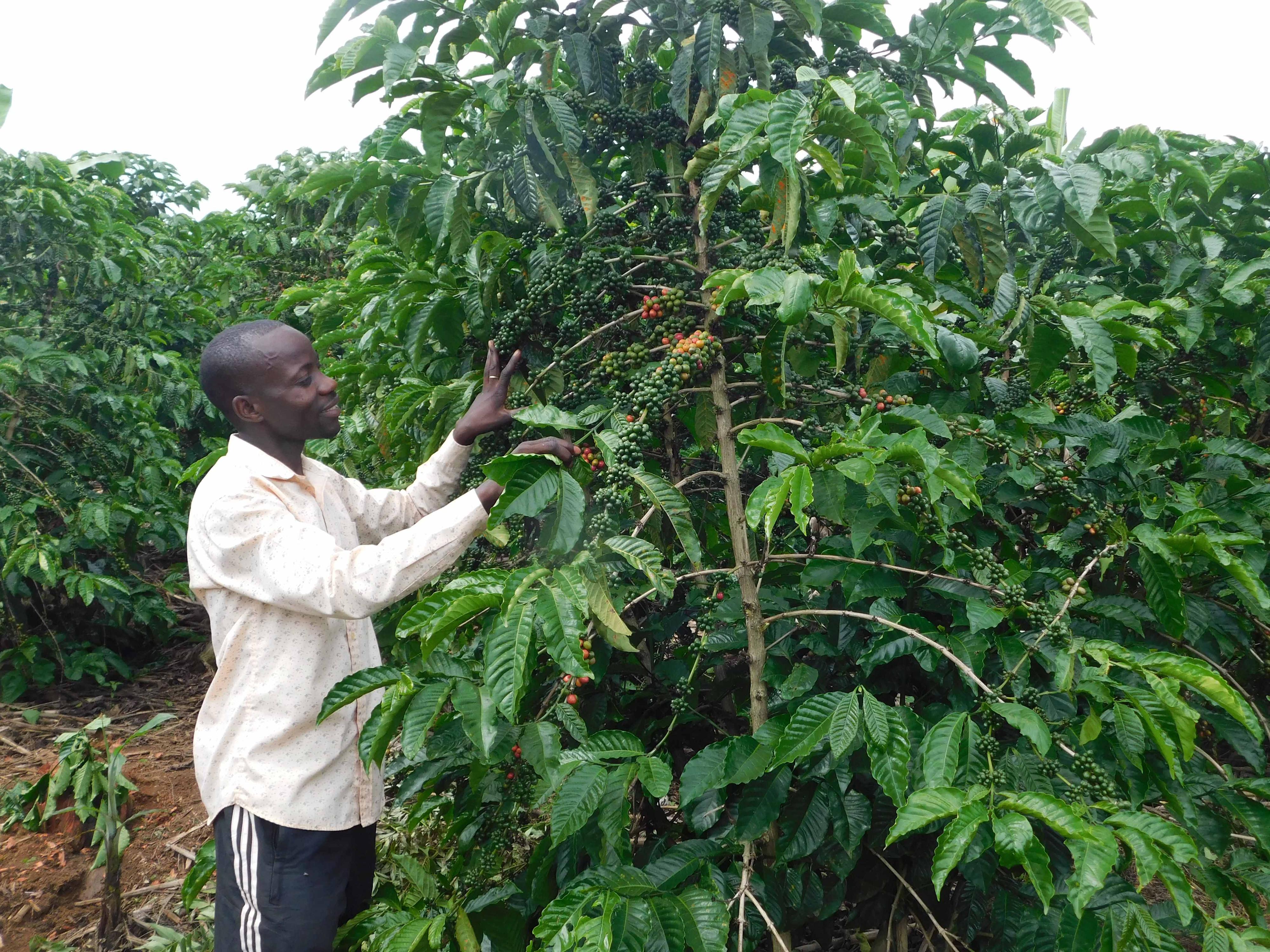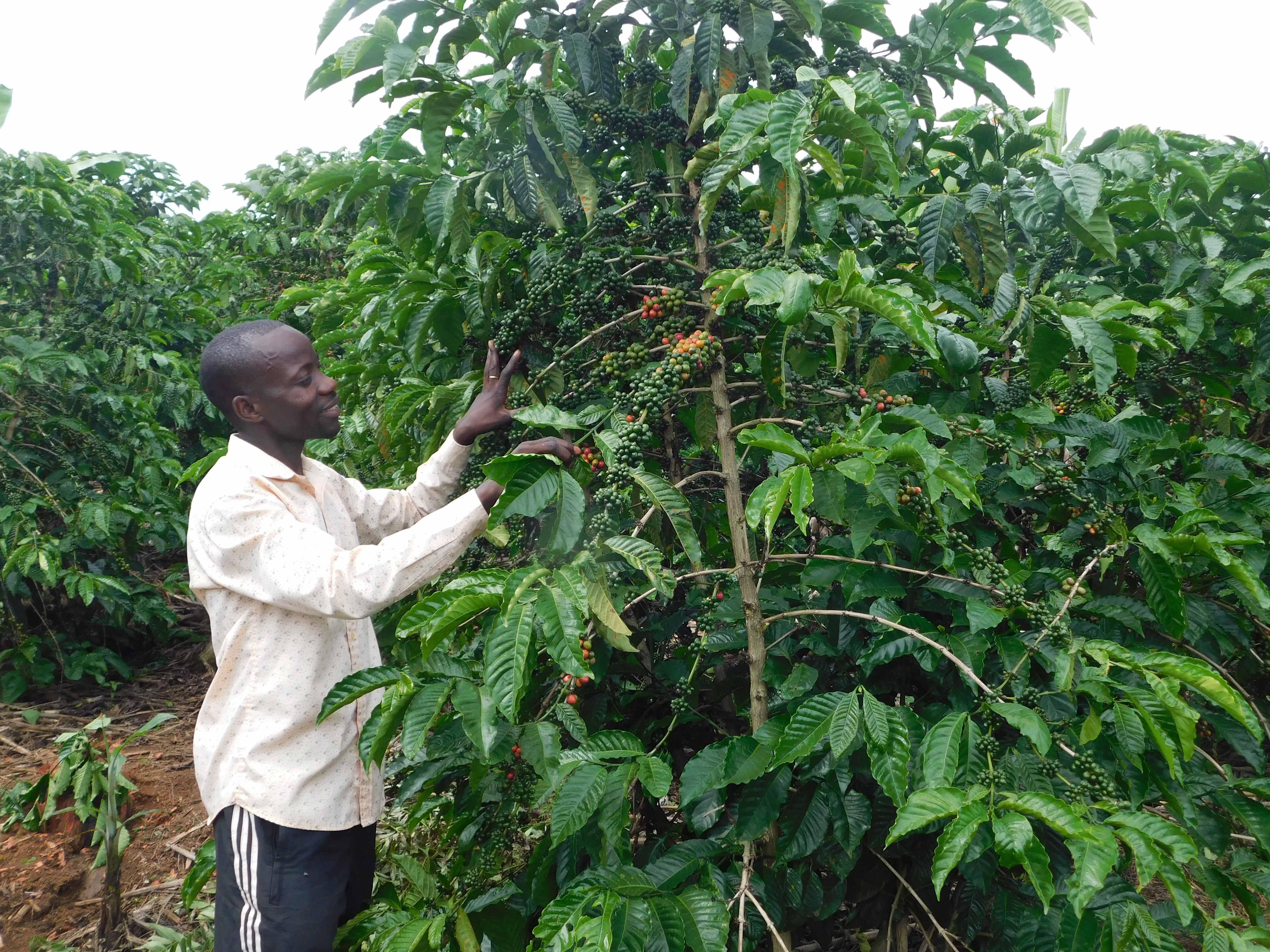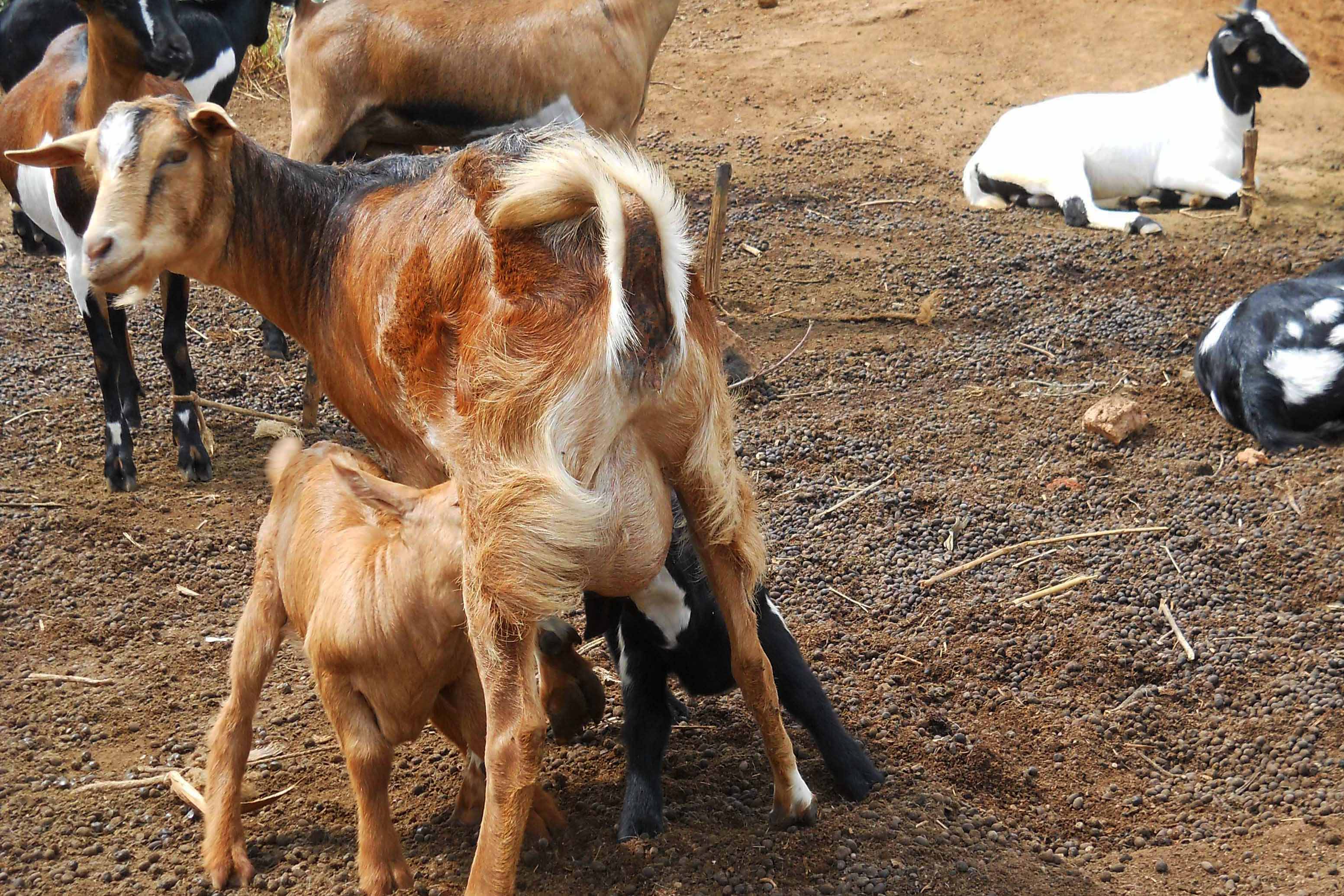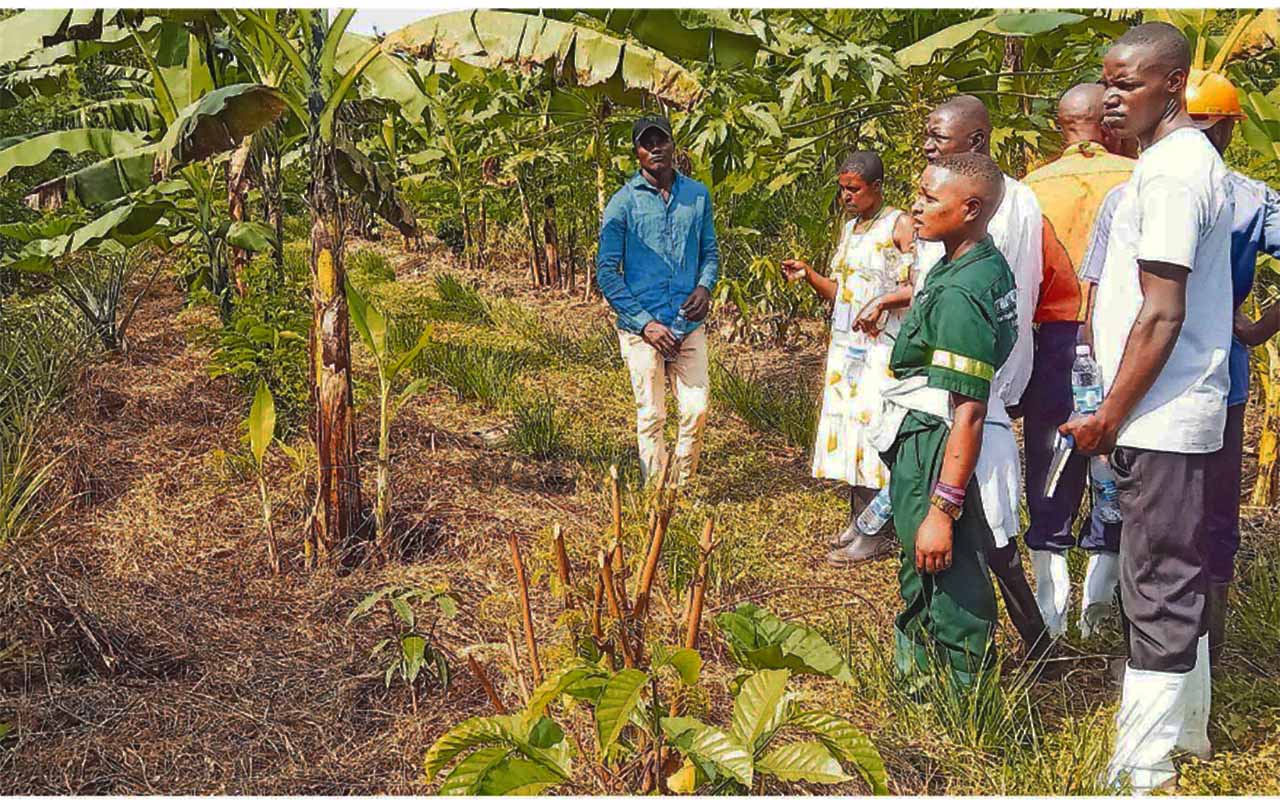
A farmer admires one of the best performing coffee trees in his garden. Photo/ Michael J Ssali
Last week, Seeds of Gold received several calls from beginner farmers enquiring about the agronomy of Robusta coffee. The mad rush for coffee farming by Ugandans has hit record highs following the recent surge in prices of the crop at the world market.
This article will guide you the new farmers in steps to follow as you prepare to join and cash in from the beverage crop that has taken the world like a wild fire.
Introduction to coffee growing
Coffee is a flowering plant which is being cultivated for its grains/seeds called ‘coffee beans’. Many coffee products including beverages are made from these freshly grown coffee beans. When it comes to planting size, these trees are small. Coffee is one of the popular commodity crops plays a major role in the world economy.
Brazil occupies the number one position in coffee production in the world. In the commercial aspect, the coffee is a major export crop for many countries across the globe. There are many species of coffee cultivated across the globe. However, “coffee Arabica” accounts for 80 percent of coffee production in the world. Other species of coffee is Robusta coffee accounts for about 20 percent of world coffee production.
The coffee tree produces purple or red cherries (edible fruits) and these cherries can consist of seeds (coffee beans). Coffee trees are bush or tree type that can reach a height of 12 feet. The coffee plant flowers have an excellent aroma and usually exists in white colour.
Once coffee orchard is established, it can produce coffee beans up to 55 to 60 years. Generally, coffee plants growing fruits beans/cherries) after 3 to 4 years of planting (especially Coffee Arabica).
Climate requirement
Climatic conditions play a major role in coffee growing. The Arabica can be cultivated at high altitude from 900 meters to 1600 meters. However, it can be grown well to lower elevations as well.The main disadvantage of cultivating coffee beans at high altitudes can result in late maturity and the crop may be damaged due to frost conditions and high winds.
When it comes to rainfall requirement, the coffee crop grows well with an evenly distributed annual rainfall of 2,200 to 2300 mm. This crop is very sensitive to high rainfall conditions and this may cause rotting of leaves and fungal disease.
Soil
Coffee crop may be grown on a wide range of soils. However, the shallow soils (sandy loam) with good organic matter to virgin soils on steep mountain slopes or almost flatlands are ideal its cultivation. You must consider the water balance of soil as this can play a vital role in coffee growing.
Commercial coffee growers should go for soil testing. Any soil nutrient deficiencies should be supplemented before starting a coffee garden. For high yields and quality produces, the pH of the soil should be between 5.0 – 6.0.PropagationCoffee crop is propagated by seeds and cuttings. Selection of quality seeds is very important in coffee growing. Make sure the seeds are heavy broad and boat-shaped. Remove any pulp from seeds by hand and these seeds should be rubbed with ash in order to avoid any sticking.
Coffee seeds should be allowed to dry under shade. Generally, from 4000 to 5000 coffee seeds are required to cover one-hectare land. It is recommended to sow these seeds 2.5 cm apart.
It takes about 30 to 40 days for germination after sowing in the field or nursery beds. These coffee seedlings should be uprooted and transplanted into polythene bags or in nursery beds at a spacing of 25 cm.
Preparation of land and spacing
For better coffee orchard establishment, the land should be prepared very well by giving 4 or 5 ploughings and harrowing to bring the soil to fine tilth stage. As part of this preparation, remove any stones/debris/ and weeds from previous crops.
Commercial coffee growers should consider soil testing to measure soil fertility and suitability. Based on soil test reports, any nutrients and micronutrients should be supplemented in the soil before planting the seedlings.
In the case of fertilisers applications such as phosphorus and lime, these should be thoroughly incorporated by plowing and disking the soil several months before transplanting the coffee seedlings in the field.
Well, planting distance or space vary from variety to variety and mainly depends on topography and soil fertility. The general spacing of different species of coffee is 2 m x 3 m and 3 m x 3 m for Arabica and Robusta respectively.
Planting
When it comes to the plantation, straight row planting with an east-west orientation is preferred layout in coffee growing.The coffee crop is planted during or just before the rainy season as this crop requires moist soil conditions and cool climate for better establishment and growth.For better coffee seedling emergence, the space between the rows should be 15 cm to 20 cm. Within the rows, coffee seeds should be placed at 3 cm to 5 cm distance with 0.5 cm to1 cm depth flat side down.
Irrigation
The frequency of irrigation in coffee growing depends on the type of soil, moisture level in the soil, plant age and climate. There are many irrigation methods are available like drip irrigation, sprinkler irrigation, microjet, and basin irrigation can be adopted in coffee growing.
However, drip irrigation is the best method for best utilisation of water and fertilizers. This can also control weed growth at plant basins.
Under irrigated conditions, each coffee plant requires 50 to 55 mm water and this should be applied before transplanting.
Weed control
Digging and forking open should be done during the months of September, November and again in February and March. Weed control can be done during the initial years. Chemical weedicides like Dalapon can be used for controlling grasses. Amino salt of 2, 4 – D can be used or controlling broad-leaved weeds.
Mulching
Mulching is another task that can provide weed control and prevent moisture loss and soil erosion. Another benefit of mulching is, it can enrich the soil, moderates of excessive soil temperature and improves soil texture. In most of the cases, mulching material can convert into excellent organic matter.
Pruning
Pruning includes removal of dried, dead branches, and any unhealthy branches. This operation includes part of pole pruning and this may be done once in four years to bring back to good shape and control unwanted shoots. Make sure this task is done immediately after harvesting.NoteNext week, we shall highlight the pests and diseases, harvesting and post harvesting technics, storage and marketing.








